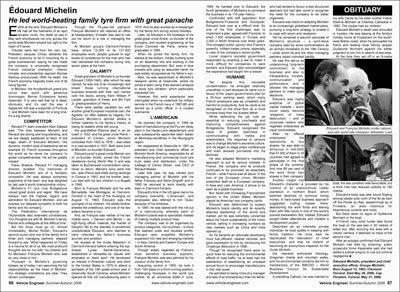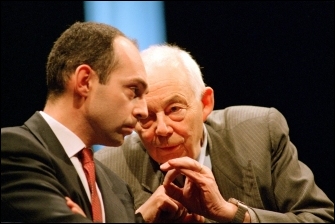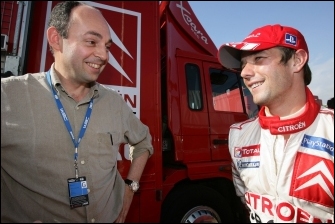|
Édouard Michelin He led world-beating family tyre firm with great panache
EVEN at the end, Édouard Michelin’s life had all the hallmarks of an epic dynastic novel. His death at sea in May sent shockwaves not only across the world-wide Michelin empire but right to the heart of France. Tributes were led from the very top. Président Jacques Chirac declared the French economy to be in mourning for a great businessman, saying he had made the company ‘a universally recognised French industrial champion’. Interior minister and presidential aspirant Nicolas Sarkozy pronounced: ‘With his death, the French economy tragically loses one of its rising figures.’ In Monaco, the thunderstruck grand prix circus was quick with generous hommages. Bernie Ecclestone lamely observed: ‘It is very sad that he is dead, obviously, and it’s sad the way it happened. He was a supporter of Formula 1, and Michelin have been for a long time. It’s a big shame.’ competitor Renault F1 team president Alain Dassas said: ‘The links between Michelin and Renault are strong and long-standing, and we are deeply saddened to learn of the tragic death of Édouard Michelin. His dynamic, modern style of leadership set an example for French business throughout the world as he drove his company to global competitiveness. He will be greatly missed.’ Flavio Briatore, Renault F1 managing director, recalled: ‘Our memories of Édouard Michelin are of a fantastic competitor. He was always extremely supportive of the team, and was delighted by last year’s world championship victory.’ Michelin’s F1 tyre rival Bridgestone voiced great shock and regret: ‘We have always had the highest regard and admiration for Édouard Michelin, and we express our deepest sympathy to both his family and his company.’ The Fédération International de l’Automobile also extended condolences: ‘Our thoughts are with M. Michelin’s family, friends and colleagues at this difficult time.’ But the show must go on. Almost immediately, Michel Rollier, Édouard’s second cousin and one of the family firm’s three joint managing partners, stepped forward to say: ‘What happened on Friday is a trauma for all of us. My most profound thoughts are for his wife, his children and for Monsieur François Michelin who was so very close to him. ‘Pursuant to Michelin’s governing bylaws, as of today, I am assuming the full responsibilities as the head of Michelin. Our strategic orientations are clear. They remain unchanged.’ Though the 79-year-old patriarch François Michelin’s still retained an office at headquarters, ill-health was said to rule out his return to a role in managing the firm. At Michelin group’s Clermont-Ferrand base, where 15,000 of its 127,000 employees work, people queued to sign books of condolence for the man who had had radicalised the company during only seven years at the helm. calamity Great-grandson of Michelin’s co-founder Édouard (1859-1940), after whom he was named, he was one of an increasingly rare breed: those running international business empires with their own names over the doors, among them William P Lauder, grandson of Estée, and Bill Ford Jr, great-grandson of Henry. There were sadder parallels too with another great European industrial clan, the Agnellis, so often stalked by tragedy. For Édouard Michelin’s demise added a further calamity to his family’s history of losing its leaders while still young. His grandfather Étienne died in an air crash in 1932, and his great uncle Pierre – president of Citröen, which Michelin controlled from 1935 to 1976 – was killed in a road accident in 1937. Both were sons of Michelin co-founder Édouard. Édouard junior’s great-uncle Marcel, son of co-founder André, joined the French résistance during World War II and was taken to Buchenwald concentration camp, never to return. Marcel’s sons were lost too: Jean-Pierre was killed during landings in Corsica in 1943, and his brother Jean-Luc died with his two children in a Bugatti in 1949. Born to François Michelin and his wife Bernadette, née Montagne, at Clermont-Ferrand in the heart of the Auvergne on August 13, 1963, Édouard was the youngest of six children. His eldest brother entered the priesthood, and one of his two sisters became a nun. And, as François saw neither of his two middle sons – Damien and Benôit – as high-flying officer material, the mantle of Dauphin fell to the talented if sometimes unpredictable Édouard, who seemed to have inherited his father’s business acumen and ambition. He studied at the Ecôle Massillon in Clermont-Ferrand before entering the top-drawer Lycée Sainte-Geneviève, established in Versailles by Jesuits with emphasis on ‘team spirit’. He developed an interest in American culture, and went to the United States in 1979 to attend a semester of the 10th grade school year in Greenville, South Carolina, where Michelin opened its first US manufacturing plant in 1975. And he also worked as a messenger for the family firm during school holidays. Later, he followed in the footsteps of his great-great uncle André, co-founder of the company, and studied engineering at the École Centrale de Paris, where he graduated in 1985. When he joined the family firm, he started at the bottom, initially building tyres on an assembly line and working in the purchasing department. But, even in blue overalls and using an assumed name, he was widely recognised as his father’s son. Next, he was apprenticed to Michelin’s research centre at Greenville, where he joined a team using finite element analysis to study tyre vibration, which particularly interested him. However, this ‘work experience’ was interrupted when he undertook his military service in the French navy in 1987-88, and served as a junior officer in a nuclear submarine. L’Americain He rejoined the company in 1989 as head of manufacturing at the Puy-en-Velay plant in the Haute-Loire département, and was subsequently appointed team leader at Montceau-les-Mines in the Bourgogne region. He reappeared at Greenville In 1991 as president and chief operations officer of Michelin North America, responsible for all manufacturing and commercial truck tyre truck sales and distribution, under the tutelage of Carlos Ghosn, now CEO of Renault-Nissan. Later that year, he was named joint managing partner of Michelin with his father François and René Zingraff, and in 1993 he returned to work directly with them in Clermont-Ferrand. Édouard’s time in the US gave rise to his company nickname, ‘L’Americain’, and employees also referred to him ‘Dudu’ because of his kindness. In 1995, he was tasked with the roll-out of a restructuring, whereby each of Michelin’s plants was to specialise, instead of making multiple product lines. The company was to be organised by product categories, not countries – a move that slashed costs and doubled profits. Édouard also propelled Michelin’s expansion into new and emerging markets – in Asia, Central and Eastern Europe and South America. Though widely regarded as France’s most secretive business supremo, François Michelin was also admired for his conduct of the family firm. Assuming control in 1955, he took it from 10th place to a front-running position, challenging Goodyear in the world tyre market. At an emotional AGM in June, 1999, he handed over to Édouard, the fourth generation of Michelins to command the business in its 110-year history. Confronted with stiff opposition from Bridgestone-Firestone and Goodyear, Édouard took over at a difficult time. So one of his first challenges was to implement a plan, agreed with François, to shed 7,500 employees in Europe and 2,000 in North America over three years. This enraged public opinion and France’s powerful, militant trades unions, especially in view of the company’s record profits. Lionel Jospin’s socialist government responded by enacting a law to make it more difficult for companies to sack workers, and Édouard later acknowledged the experience had taught him a lesson. Humane Yet, despite this inevitable condemnation, he emerged relatively unscathed, in part because he came out in favour of the Jospin government’s plan for a 35-hour working week, which many French employers saw as unrealistic and harmful to productivity. And he came to be recognised on the shop floor as a more humane boss than his austere father. While defending the job cuts as essential to reducing overheads and improving competitiveness against Bridgestone, Édouard recognised the value of greater openness in communicating with media and shareholders. His response to censure was to change Michelin’s secretive culture, and he began to stage press conferences and even allowed journalists into his factories. He also adapted Michelin’s marketing approach to suit its various markets. In France, the company and its products continued to be promoted as essentially French – what France was all about. In the rest of the European Union, Michelin presented itself as a European company. In Asia and Latin America, it strove to be seen as a global business. But, faced with increasing Francophobe opinion in the United States, Michelin played its American tyre company cards. Édouard was determined to sustain Michelin’s brand identity and its recently attained leadership of the world tyre market, yet he was extremely concerned about the future sustainability of the motor vehicle, selling in increasing numbers as new markets such as China and India opened up. So he became an advocate developing more fuel efficient, cleaner vehicles, and gave expression to this by introducing the Challenge Bibendum in 1998. Though he recognised there were no quick fixes for reducing the environmental effects of road traffic, he at least had the satisfaction of establishing an unbiased annual forum to encourage manufacturers in this vital quest. COMMITMENT He admitted to being more of a manager and less of an entrepreneur than his father, who had tended to favour a less structured approach but had later come to recognise the need for the company to be better organised. Édouard was intent on adapting Michelin to an increasingly globalised market place, pursuing a long-term strategy to enable it to cope with boom and recession. Yet he remained a staunch advocate of Michelin’s structure – a joint-stock company seen by some commentators as an archaic throwback to the 19th Century – under which he and the other managing partners risked unlimited liability. He saw this set-up as underpinning long-term commitment to the business and also to transparency, honesty, communication and performance, and it allowed the managing partners to make quick decisions. Édouard was highly sceptical of global capital markets – which could easily become ‘weapons of mass destruction’ – and of corporate raiders who regarded enterprises as mere commodities. After he offered employees the opportunity to buy shares, he was able to announce in mid-2002 that 57,000 of them in 16 countries had agreed to participate in the first phase of the scheme. And now 69 per cent of the work force own shares in their company. Another insight into Édouard’s character is provided by his conduct of an uneconomical rubber plantation in northern Brazil, which seemed destined to continue losing money. A hard-nosed business approach suggested cutting losses there, abandoning the work force and leaving them with little future in one of the world’s poorest backwaters. But, instead, Édouard sought better alternatives and initiated a development project. MYSTERY Described as an intensely private individual, he lived quietly in keeping with family tradition. He once said he deprecated the ‘starization’ of chief executives, and that he dreamt of becoming an anonymous inspector for the Guide Michelin. His interests embraced theology, Gregorian chants and mountain walks, and his environmental concerns led him to membership of the WBCSD – World Business Council for Sustainable Development. A practising Catholic, he was married to his wife Cécile by his elder brother Father Etienne Michelin at Chârtres Cathedral in 1992. The couple had six children. Édouard Michelin’s death was shrouded in mystery. He was staying at the family’s holiday home at Fouesnant on the south-west Breton coast, when he persuaded his friend and leading local fishing skipper Guillaume Normant against his better judgment to join him in search of sea bass. At the time they set off in an 8-metre boat, the sea condition was favourable, but a thick mist had reduced visibility to 180 metres. Édouard’s body was later found floating among lobster pots north of the Île de Sein off the Pointe du Raz, westernmost tip of Finistère, an area notorious for treacherous currents and rocks. But there were no signs of Guillaume Normant or the boat. A French navy mine hunter later found the boat on the sea bed in 50 metres of water but, after scouring the area with a robotic camera, it detected no trace of the second man. After an autopsy confirmed that Édouard Michelin had died by drowning, public prosecutor Anne Kayanakis said she had asked a judicial enquiry to rule out criminal negligence l Édouard Michelin, president and chief executive officer, Groupe Michelin. Born August 13, 1963, Clermont-Ferrand. Died May 26, 2006, Cap Finistére. Funeral, May 31, 2006. Anthony Howard 2099 words Copyright © by Anthony Howard for Vehicle Engineer Pictures: Michelin media library |


